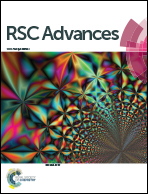Cellular uptake, imaging and pathotoxicological studies of a novel Gd[iii]–DO3A-butrol nano-formulation†
Abstract
The high adaptability of dendrimer-based contrast agents (CAs) is ideal for the reliable molecular imaging of cancerous tissues. Gadobutrol (Gd3+[III]–DO3A-butrol or Gadovist) is a commercially produced contrast agent used in clinical settings. In this study, gadobutrol was nano-formulated by adding different ratios (X, 2X) of the anionic linear globular dendrimer G2 (gadobutrol–ALGD-G2 nano-formulation) to evaluate its intracellular uptake, pathotoxicity and use for in vitro and in vivo molecular imaging in cancer cells. Drug stability studies were carried out to ensure the correct formulation, after which the percentage of drug entry and levels of cytotoxicity (HEK cell line, KB cell line) were evaluated in cancer cells using the KB cell line. The intracellular uptake of gadobutrol–ALGD-G2 was measured quantitatively using inductively coupled plasma atomic emission spectrometry. The relaxometry of this CA and tumor imaging were determined using 1.5 T magnetic resonance imaging. The results indicated that the cellular uptake of gadobutrol–ALGD-G2 was about 71%. The r1 relaxation of this CA was measured as 4.75 mM−1 s−1 and on a per gadolinium [Gd3+] basis. In addition, the nano-formulated Gd[III]–DO3A-butrol was able to enter the KB cancer cells. The apoptosis assay and pathological evidence verified that the cells did not show any significant toxicity on exposure to the drug. The use of magnetic resonance imaging is feasible for the quantitative evaluation of the delivery of the drug and the detection of cancer cells. These results suggest that the new nano-formulation of gadobutrol–ALGD-G2 provides guidance for the selection of appropriate CAs for medical nanotechnology applications.
![Graphical abstract: Cellular uptake, imaging and pathotoxicological studies of a novel Gd[iii]–DO3A-butrol nano-formulation](/en/Image/Get?imageInfo.ImageType=GA&imageInfo.ImageIdentifier.ManuscriptID=C4RA05596A&imageInfo.ImageIdentifier.Year=2014)

 Please wait while we load your content...
Please wait while we load your content...